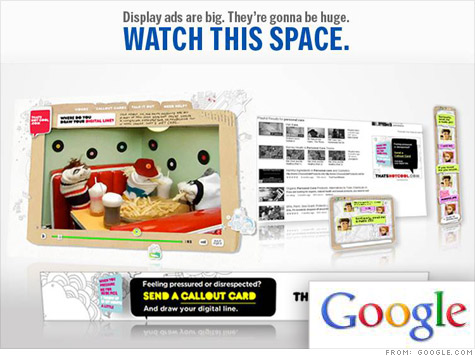Search News

Google's display ad business recently surpassed Yahoo in the United States, but the company and analysts believe it has even more room to grow.
NEW YORK (CNNMoney) -- Google became a $30 billion company on the back of search advertising -- but the company thinks its other multi-billion-dollar advertising business will be its growth engine of the future.
That other business is "display" advertising, which includes banner ads, video ads and in-app mobile ads.
Google (GOOG, Fortune 500) has only been in the market for three years. That's why it stunned just about everyone in October when it announced that its display business is on pace to bring in $2.5 billion in annual sales.
"It's quite revolutionary, and the numbers are indeed astonishing," says Karsten Weide, analyst at IDC. "It has become a very important business for Google."
The company approaches the display market in a very different way than its competitors, which include Yahoo (YHOO, Fortune 500), Microsoft (MSFT, Fortune 500) and AOL (AOL). They sell the vast majority of their display ads manually.
Google automates the process. Anyone with a credit card and a campaign to upload can buy display ads online.
Right now, Google's footprint in the space is relatively small. Unlike search, where the company grabs 60% of the advertising revenue in the U.S. market, Google has just a 15% share of the display market's sales, according to IDC.
But 15% is good enough to beat Yahoo, which had previously held the top position for about as long as the online display business has been around.
It's an even more stunning achievement considering that just 2.5% of the display ads served online are on Google's owned and operated sites, according to the latest quarterly study by traffic tracker ComScore. That puts Google in fifth place, behind the likes of Facebook, Yahoo, Microsoft and AOL.
Analysts tend to downplay the ComScore number, which measures viewer impressions rather than cold, hard cash. In that battlefield, Google has quickly become very formidable.
"It's not just our next large business, it's already a big business," Neal Mohan, Google's vice president of display advertising products, told CNNMoney. "But there's still tremendous room for growth."
Citigroup's Mark Mahaney agrees, saying he expects that Google's display business will grow up to 40% this year, driven mainly by market share gains against its rivals.
Google thinks the whole market is going to expand fast. Mohan estimates that the entire global display field is between $20 billion and $25 billion today. By 2015, he thinks it will double in size to $50 billion, and eventually grow as large as $200 billion annually.
In just one year -- from 2009 to 2010 -- Google's 1,000 largest advertisers increased their display purchases by 75%, he says.
One of the prime catalysts for that growth is online video. It currently makes up 40% of all Internet traffic and will exceed 91% by 2014, according to forecasts from Cisco (CSCO, Fortune 500).
That will give companies abundant opportunities for in-video advertising campaigns. "As video becomes a more prominent medium on the Web, the predominant kind of advertising will become display," Mohan predicts.
But there are some significant obstacles in the way. Online video usage has been surging for years, but the ad dollars have lagged. Mohan acknowledges a "disequilibrium" between the amount of time people spend on YouTube and the amount of money Google makes on it.
Advertisers are comfortable with search ads because they're very effective: The ads are directly related to keywords that a user has typed in. A Google search for "flat screen TV," for instance, currently returns extremely relevant ads for flat screen TVs at Wal-Mart (WMT, Fortune 500), Best Buy (BBY, Fortune 500) and Sears (SHLD, Fortune 500), among others.
Display ads can be more imaginative and interactive -- but they're also harder to make and harder to monetize.
Google's solution is to throw tools and technology at the problem. For example, its recent purchase of Teracent allows companies to launch a single ad campaign with dozens of variables that can be altered based on conditions like location, weather, and a user's tastes.
"We have new ways to target, measure and feature creativity, which lend themselves to better ad performance," Mohan says.
So can Google maintain its momentum and become as dominant in display as it is in search?
"The jury's still out," Weide says. "A big portion will still be sold manually, and most of Google's advertisers aren't the big brand advertisers that Yahoo and AOL attract. But if that changes, and they find Google to be more effective, that'll become a big problem for Yahoo." ![]()